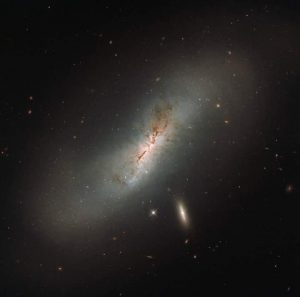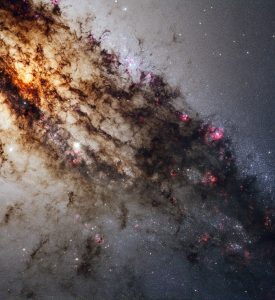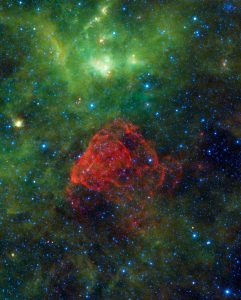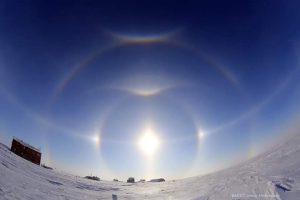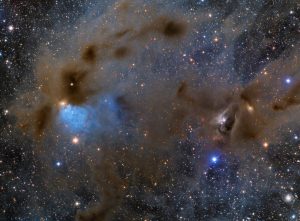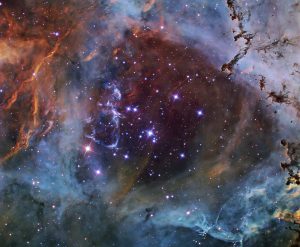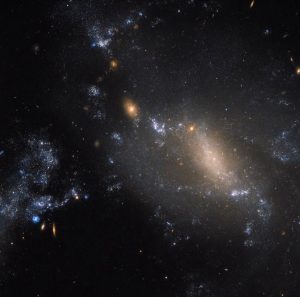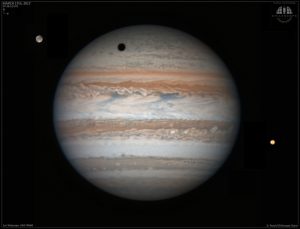Immagini
NGC 4424 e la sua compagna
In questa nuova, straordinaria immagine di Hubble sono chiaramente visibili due galassie, la più grande delle quali si chiama NGC 4424. Questa galassia è inserita nel New General Catalogue of Nebulae and Clusters of Stars (NGC), compilato nel 1888. Continua a leggere
NGC 602: Sotto l’Ala della Piccola Nube
In questa straordinaria immagine composita della regione nota come l’Ala della Piccola Nube di Magellano i dati a raggi X dell’Osservatorio Chandra sono mostrati in viola, i dati ottici del telescopio Hubble in rosso, verde e blu, i dati a infrarossi del telescopio Spitzer in rosso. Continua a leggere
Spettacolare Visione di Centaurus A
Simile ad incombenti nuvole di pioggia in un giorno di tempesta, scie oscure di polveri attraversano la gigantesca galassia ellittica Centaurus A. L’immagine di Hubble rivela il vibrante splendore dei giovani ammassi stellari blu e dettagli di regioni normalmente oscurate dalla polvere. Continua a leggere
Un’Antica Supernova
Circa 3700 anni fa gli abitanti della Terra potrebbero avere visto una nuova stella brillare in cielo. Quando si è affievolita ed è scomparsa dalla vista, probabilmente è stata dimenticata, finché i moderni astronomi non hanno trovato i suoi resti, chiamati Puppis A. Continua a leggere
Polvere di Diamanti in Cielo
La primavera è arrivata nell’emisfero boreale, ma è ancora freddo sopra il Circolo Polare Artico in Alaska. Il giorno 27 Marzo cristalli di ghiaccio hanno riempito l’aria del delta del fiume Coleville sulla costa nord. Quando la luce solare è sorta “un incredibile rete di aloni ha circondato il sole”, racconta il fotografo James Helmericks. Continua a leggere
Nebulose e Giovani Stelle nel Toro
Questo complesso di nubi polverose si trova lungo i margini della nube molecolare del Toro, a circa 450 anni luce di distanza. In questa splendida scena cosmica stanno nascendo nuove stelle. Continua a leggere
Nel Cuore della Rosetta
Nel cuore della Nebulosa Rosetta risplende un brillante ammasso aperto di stelle che illumina la nube. Le stelle di NGC 2244 si sono formate dal gas circostante soltanto pochi milioni di anni fa. Continua a leggere
Lo scavalcamento di fase di Venere
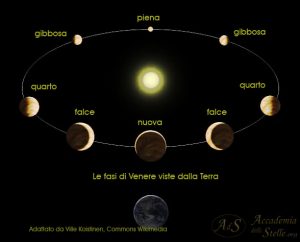 È noto che Venere si osserva bene dopo il tramonto oppure prima dell’alba (a seconda di come si trova sulla sua orbita rispetto alla Terra), ovvero come Stella della Sera o Stella del Mattino, e che in certi periodi non si vede affatto poichè si trova invece “in congiunzione” con il Sole. Ciò che ce ne impedisce l’osservazione è l’eccessiva luminosità del Sole: quando Venere ha una grande distanza angolare è facile osservarla, quando invece Venere è troppo vicina al Sole, sparisce. Continua a leggere
È noto che Venere si osserva bene dopo il tramonto oppure prima dell’alba (a seconda di come si trova sulla sua orbita rispetto alla Terra), ovvero come Stella della Sera o Stella del Mattino, e che in certi periodi non si vede affatto poichè si trova invece “in congiunzione” con il Sole. Ciò che ce ne impedisce l’osservazione è l’eccessiva luminosità del Sole: quando Venere ha una grande distanza angolare è facile osservarla, quando invece Venere è troppo vicina al Sole, sparisce. Continua a leggere
La Strana Coppia Galattica
Questa nuova, particolare immagine del telescopio Hubble inquadra una strana coppia di galassie interagenti, localizzate a circa 60 milioni di anni luce di distanza nella costellazione del Leone. Continua a leggere
L’Ombra di Ganimede
Avvicinandosi all’opposizione del prossimo 7 aprile, Giove offre una delle migliori visioni in cielo per gli astrofili. Questa immagine straordinariamente definita del più grande gigante gassoso del Sistema Solare è stata ripresa il 17 Marzo da un remoto osservatorio in Cile. Continua a leggere
